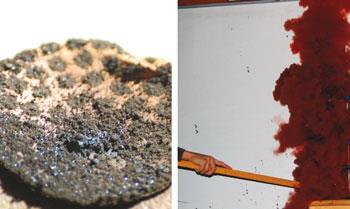Create a beautiful cloud of vapour mixed and gas with this safe contact explosive demonstration
Contact explosives are rarely encountered in the classroom, owing to their unstable nature and the associated danger of detonation. However, using the following method, a small quantity of dry NI3(s) crystals can be used to produce an impressive 'crack' and a beautiful cloud of purple iodine vapour mixed with nitrogen gas. Quantities must be kept small so that the demonstration is safe. Do not be tempted to deviate from the method.

Kit
- 50 ml beaker, 100 ml conical flasks
- filter funnel and filter paper
- glass stirring rod
- pestle and mortar
- 0.48 g iodine crystals
- 0.880 M concentrated ammonia solution
- 100 ml 5 M NaOH solution
- heat-proof mat; metre rule
Procedure
Working in a fume cupboard, wearing a face shield and nitrile gloves, use a pestle and mortar to grind 0.5 g of iodine crystals into a fine powder and transfer to a small beaker. To the iodine powder add approximately 4 ml of concentrated ammonia solution and stir briefly using a glass rod. Allow the mixture to stand for ca five minutes for the reaction to complete.
To extract the solid explosive, swirl the mixture to suspend the solid in the ammonia solution and then pour onto a filter paper held over a conical flask. While the beaker is upturned over the filter paper use a plastic teat pipette to squirt concentrated ammonia solution to wash any residue NI3 onto the filter paper.
Turn off the fume cupboard to prevent air movement. Remove the wet filter paper containing the NI3(s), open up and place on a heat-proof mat so that it lies flat. Leave to dry in the fume cupboard while taking adequate precautions to prevent students or other staff getting near the experiment - place stools or similar in front of the cupboard.
To destroy any residual explosive on the glass rod or in the beaker, add 5 M NaOH solution (caution: corrosive) and leave until no black solid is visible. Once the filter paper is dry it is possible to detonate the crystals by tickling with a feather attached to a metre rule. Humidity and room temperature can prolong the drying process and reduce the shock-sensitivity of the explosive and so a greater 'strike' might be required to detonate it.
Wearing a face shield and holding a metre rule at arms length hit the NI3 to produce the explosion and then switch on the fume cupboard to remove the iodine vapour cloud. Tap the rule against a wall to detonate any remaining NI3 that adheres. Place the filter paper remains into the 5 M NaOH solution, rinse until colourless and put in the refuse.
Note: the photograph (right) shows six, stacked 0.5 g samples exploding, but these quantities far exceed what is permitted without a police certificate and are not recommended for a classroom demonstration, owing to the large volume of iodine vapour produced.
Special tips
Most iodine stains can be removed using a 1 M sodium thiosulfate solution. Cold, damp conditions will significantly increase the drying time. If the sample was still damp when struck, brushing the surrounding area will detonate and therefore remove any stray/dispersed crystals.
Teaching goals
Nitrogen triiodide decomposes according to the following equation:
2NI3(s) → N2(g) + 3I2(g)
This reaction provides an excellent opportunity for post-16 students to consider the entropy changes during the reaction. The change from two moles of ordered, solid crystals into four moles of gas is consistent with the large ΔSθsystem, and this can be easily visualised during the reaction, as can the exothermic nature of the reaction and thus the positive entropy change of the surroundings (ΔSθsurroundings = -ΔH/T ). Therefore the total entropy change (ΔSθtotal = ΔSθsystem + ΔSθsurroundings) will be expected to be large and positive, indicating a spontaneous change which will go to completion.
Safety
- Never attempt to store NI3 or confine in any way, and do not be tempted to increase the scale or deviate from the procedure.
- All parts of the preparation must be done in a fume cupboard and you must wear a face shield and gloves.
- Concentrated ammonia solution is corrosive and iodine is harmful; both can burn the skin. Ammonia is toxic by inhalation and, like iodine vapour, irritating to the respiratory system and eyes, and 5 M NaOH solution is corrosive. Dispose of all products down a sink in the fume cupboard with plenty of water.
- If leaving NI3 to dry overnight make sure signs are placed on the locked classroom door preventing entry to others. The fume cupboard may be out of use for other purposes for some time. Students and staff need to be warned about this.
- Ear defenders are required for the demonstrator, and students must cover their ears and wear safety goggles.
- NI3 is the subject of a CLEAPSS risk assessment, see the password-protected part of the CLEAPSS website (SRA15).
- Quantities of iodine greater than 0.48 g require a police certificate. Do not attempt to stack samples of iodine.









No comments yet